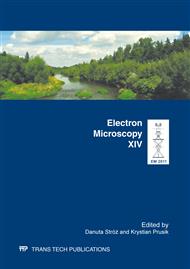p.279
p.283
p.287
p.292
p.296
p.301
p.305
p.311
p.315
Characterization of Precipitation Process in T24 Steel after Long–Term Ageing
Abstract:
The T24 steel belongs to a new group of bainitic steels introduced currently to the power industry. Higher requirements connected with applying higher steam parameters in power units are the reason why the low-alloy steels used so far can no longer be applied. Therefore, new T24 steel has been developed in Europe on the basis of 10CrMo9-10 (10H2M) steel, which has been used in the power industry for many years, as a result of modification in its chemical composition. This modification consisted in introducing additions and microadditions of titanium, vanadium, boron and nitrogen into the base steel. As a result of the modification the new-found T24 steel is characterized by higher mechanical properties in comparison with the base steel, which allows to use the steel for tight shields in the new supercritical power units. The material for research was low-alloy bainitic T24 steel. Samples for examination were taken from a pipe section of the following size: outside diameter 44.5mm, wall thickness 7mm. Samples were isothermally aged in the air atmosphere, at the temperature of 580°C and at times up to 12 000 hours. Changes in the microstructure were observed and recorded by means of high-resolution electron microscope, JOEL JEM 3010. Identification of the precipitates was made using carbon extraction replicas and thin foils with the SAED method. The aim of research was the analysis of precipitation processes. They are extremely important in the context of long-term service and maintaining strength parameters above the minimum level. The tests were performed on T24 steel for the as-received condition (after heat treatment) and after 12 000 hours of ageing at the temperature of 580°C. The research made it possible to determine the morphology of precipitates. It also allowed to establish the sequence of precipitation process for the examined steel.
Info:
Periodical:
Pages:
296-300
Citation:
Online since:
March 2012
Authors:
Keywords:
Price:
Сopyright:
© 2012 Trans Tech Publications Ltd. All Rights Reserved
Share:
Citation:


